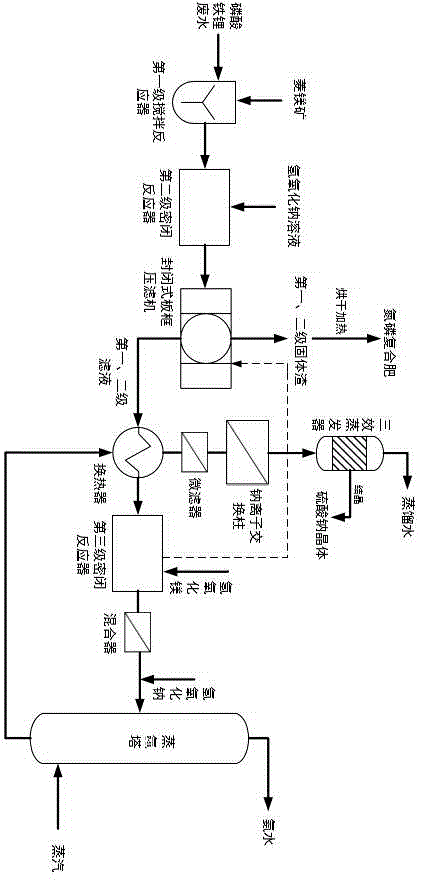Recycling technique of lithium iron phosphate production wastewater
A technology for the production of wastewater and lithium iron phosphate, which is applied in water/sewage treatment, multi-stage water/sewage treatment, water/sludge/sewage treatment, etc. It can solve the difficult treatment of lithium iron phosphate production wastewater and the immeasurable market prospects, etc. problems, to achieve good application prospects, stable treatment effect, and simple process
- Summary
- Abstract
- Description
- Claims
- Application Information
AI Technical Summary
Problems solved by technology
Method used
Image
Examples
Embodiment 1
[0028] The lithium iron phosphate production wastewater discharged from a lithium battery production plant enters the stirred reactor after pretreatment, and adds cheap magnesite powder while stirring, controls the pH of the mixed solution at 7, and then pumps the mixed solution into the closed reaction Add sodium hydroxide solution into the reactor, adjust the pH of the reaction solution to 8, pump the mixed slurry into a closed plate and frame filter for filtration, and obtain solid slag struvite and sulfate filtrate containing high concentration of ammonia nitrogen.
[0029] The filtrate is pumped into another closed reactor to measure the liquid phase phosphorus concentration in the reaction solution. If the phosphorus concentration is higher than 0.1 mg / L, magnesium hydroxide is further added to continue the stirring reaction for 2 hours, and the phosphate ion is precipitated completely. The reaction mixture is then filtered through a closed plate and frame filter for the ...
Embodiment 2
[0032] The lithium iron phosphate production wastewater discharged from a lithium battery production plant enters the stirred reactor after pretreatment, and adds cheap magnesite powder while stirring, controls the pH of the mixed solution at 7.5, and then pumps the mixed solution into the closed reaction Add sodium hydroxide solution into the reactor, adjust the pH of the reaction solution to 8.5, pump the mixed slurry into a closed plate and frame filter for filtration, and obtain solid slag struvite and sulfate filtrate containing high concentration of ammonia nitrogen.
[0033] The filtrate is pumped into another closed reactor to measure the liquid phase phosphorus concentration in the reaction solution. If the phosphorus concentration is higher than 0.1 mg / L, magnesium hydroxide is further added to continue the stirring reaction for 2 hours, and the phosphate ion is precipitated completely. The reaction mixture is then filtered through a closed plate and frame filter for ...
Embodiment 3
[0036] The lithium iron phosphate production wastewater discharged from a lithium battery production plant enters the stirring reactor after pretreatment, and adds cheap magnesite powder while stirring, controls the pH of the mixed solution at 8, and then pumps the mixed solution into the closed reaction Add sodium hydroxide solution into the reactor, adjust the pH of the reaction solution to 9, pump the mixed slurry into a closed plate and frame filter for filtration, and obtain solid slag struvite and sulfate filtrate containing high concentration of ammonia nitrogen.
[0037]The filtrate is pumped into another closed reactor to measure the liquid phase phosphorus concentration in the reaction solution. If the phosphorus concentration is higher than 0.1 mg / L, magnesium hydroxide is further added to continue the stirring reaction for 2 hours, and the phosphate ion is precipitated completely. The reaction mixture is then filtered through a closed plate and frame filter for the ...
PUM
 Login to View More
Login to View More Abstract
Description
Claims
Application Information
 Login to View More
Login to View More - R&D
- Intellectual Property
- Life Sciences
- Materials
- Tech Scout
- Unparalleled Data Quality
- Higher Quality Content
- 60% Fewer Hallucinations
Browse by: Latest US Patents, China's latest patents, Technical Efficacy Thesaurus, Application Domain, Technology Topic, Popular Technical Reports.
© 2025 PatSnap. All rights reserved.Legal|Privacy policy|Modern Slavery Act Transparency Statement|Sitemap|About US| Contact US: help@patsnap.com

